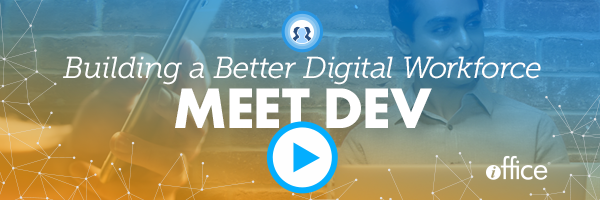Why a Workplace Strategy Is Key to Improving the Employee Experience


You’d never drive to a new destination without a map. And you’d never try to build a house without a blueprint (at least we hope not.)
So why is it that many business leaders attempt to perfect the employee experience without proper preparation? Even if they have the best intentions, they still need a plan of action and a detailed strategy. Otherwise they’re setting themselves (and their company) up for failure.
If a better employee experience is your destination, a workplace strategy is your roadmap. Simply put, it’s a way to enable peak performance and reduce costs while enhancing employee engagement. Here’s what a strong workplace strategy should entail and how to develop one.
Workplace Strategy 101
As Deloitte explains, “Work is now ‘what we do’, not ‘a place where we go’.” And in order to create a great employee experience, you must embrace this concept.
An effective workplace strategy includes three important elements, according to Deloitte:
- The physical workspace (or workplace design)
- The technology that connects employees to their workspace and to each other
- HR policies that enable work and increase efficiency
Let’s take a look at each of these in more detail and how they contribute to the employee experience.
Your Workplace Design and Space Utilization
A recent Capital One Work Environment survey found 82 percent of office professionals believe innovation starts with the workplace, yet 52 percent describe their work settings as “uninspiring.”
Employee surveys can be a helpful way to assess space quality. When employees have the opportunity to offer feedback into how they are actually using space and what factors are most important to them, they’ll be more engaged and productive.
There’s more to a well-designed workplace than good lighting, comfortable seats and inspiring artwork, however. Workplace leaders need to consider how to implement flexible workplace strategies like activity-based working, hoteling and remote working in a way that maximizes space utilization.
Technology and the Employee Experience
Pretend you’re sitting in the break room with a colleague, discussing the latest news about Tesla and you decide to see what Elon Musk has been tweeting recently. You’re not going to get up, walk back to your desk and log on to your computer. You’re going to take your phone out of your pocket and open the Twitter app.
We aren’t tethered to our personal computers anymore; we’re mobile. We expect information on demand, regardless of our location or the time of day. That’s how it needs to be in your workplace. You need to give your employees workplace technology that acts and looks like the powerful, well-designed apps they use in their personal lives. Your workforce must have access to the tools that enable them to complete their tasks, no matter where they are.
This technology is what powers the modern employee experience. And without a cloud-based workplace management solutions, you cause the workplace to revert back to a physical location where employees don’t feel creative; they feel stifled, static and stoic.
Effective Human Resources Policies
As you build a more agile workplace, your HR department needs to update its policies to support more flexible ways of working. Employees are no longer expected to be in the office tethered to their desks from 9-5 each day, but they still need to understand what’s expected of them in terms of availability. Some questions to address include:
- When employees are expected to be available each day
- What are appropriate times to schedule team meetings, particularly when team members are located in different time zones
- How their colleagues can find them when they are not physically in the office (such as through a workplace app connected to your employee directory)
- What is considered a reasonable timeframe for responding to phone calls and email
Taking the time to tackle these issues and ensure everyone in the workforce is in alignment will help your organization avoid resistance to changes in your workplace strategy.
Building a Workplace Strategy
There are five steps to building an effective workplace strategy (or improving an existing one):
- Decide what you want to achieve with your strategy. Do you want to increase retention? Decrease turnover? Inspire innovation? Foster communication and collaboration? Defining your objective(s) will give you a good starting point for your strategy.
- Evaluate how existing workspace is being used. What percentage of available space is being utilized? Are there particular workspaces that are consistently underutilized? How many employees are using a space, and when are they using it? This helps you determine whether or not your current workspaces support employee productivity.
- Identify the types of work being done in each space. Does there seem to be certain areas where employees are always collaborating and other areas where employees are working solo? With this information, you can ensure your workplace has the best mix of workspaces to meet the individual needs of each employee.
- Ask employees what they care about. Objective data is valuable, but feedback from employees on the types of spaces and the kind of environment they most prefer is just as important for your workplace strategy.
- Consider the impact of impending changes. Are you planning on implementing major updates to your software or service? Is there the potential for office relocation in the near future? Is a workforce expansion or hiring freeze on the horizon? Significant changes like these will have a big impact on your workplace and should be considered when developing your strategy.
I’ll leave you with some wise words from Lawrence Abrahamson, Design Lead at IDEO: “Workplace is about people. There can be meetings about efficiencies and optimization, but in the end we need to design for the individuals who are using the spaces.” That’s the simplest definition of what a workplace strategy is: Designing your workplace, technology and policies in a way that allows your employees to do their best work.
